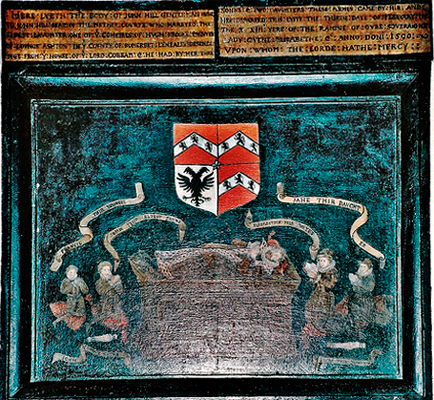|
HEREFORDSHIRE - 3 |
| |
Ledbury
Little
Hereford Lyonshall Lugwardine
Moccas
Much Cowarne
Much Marcle
Pembridge
Stretford
(Tarrington)
Ullingswick
(Weobley)
Wolferlow
|
| <Herefordshire - 1> <Herefordshire
- 2>
<Herefordshire - Hereford Cathedral> |
| |
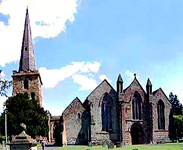 |
Ledbury - St
Michael and All Angels |
 |
A medium sized town with a relatively large
church, always open during daylight hours, and with a welcome
desk. And strictly no charge! The church is on the edge of town
presumably build on what was originally park land, but now
surrounded by a housing estate. Parking is difficult: there are a few parking spaces
outside the church but these may well be restricted, although
there is no indication of this, so it is best to ask at the
welcome desk. (Although you would not have realized there would
be one before parking or reading this note!) Otherwise park in a
pay car park (not expensive) some walk from the church.
O/S Ref: SO 713 377 |

|
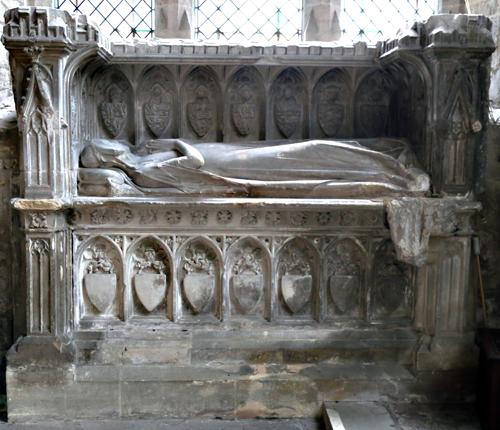
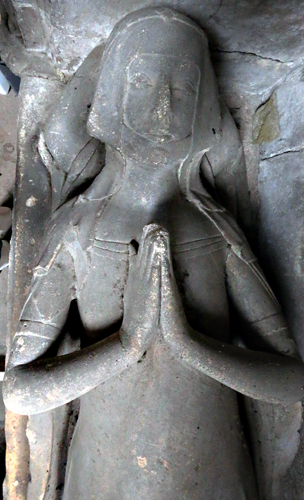 |

Above
and right: [4] Probably a sister of Grynbald
? Pauncefot who married a Pauncefot who married a Carew.
She wears a long gown which is draped over the side of
the tomb chest. The tomb chest has seven cinquefoil canopies, each with
a blank shield hanging from foliage. The canopy under
the vaulting has eleven cinquefoil panels, each with
a carved shield of arms: Carew (four times),
Pauncefot (three times), and two lions passant
(four times).
This monument is similar to the Blanche Mortimer monument in
Much Marcle church (see below) but is not as fine,
having lost the upper part of the canopy and all the polychrome.
It has also never been restored in recent times |
Note: Initially I had some
difficulty in finding this monument in the church ; they
did not know of it at the welcome desk. It was certainly not
obvious in the main body of the church but I had my somewhat
illegible note book with me which indicated it was in the north
chapel. I had seen the south chapel but had not noticed its
northern equivalent, there being just an organ there. But there
was a passage on the east side of that instrument and this led
to the north chapel and the lady I sought. Unfortunately the
north chapel is used as the church store/ dumping ground so I
had to remove a number of items from in front of the monument in
order to take the above photographs - and then move them all
back again. All while endured the playing of the organ.
So if you seek her, that's where she'll be. Not a very
satisfactory arrangement but at least it was not locked.
|
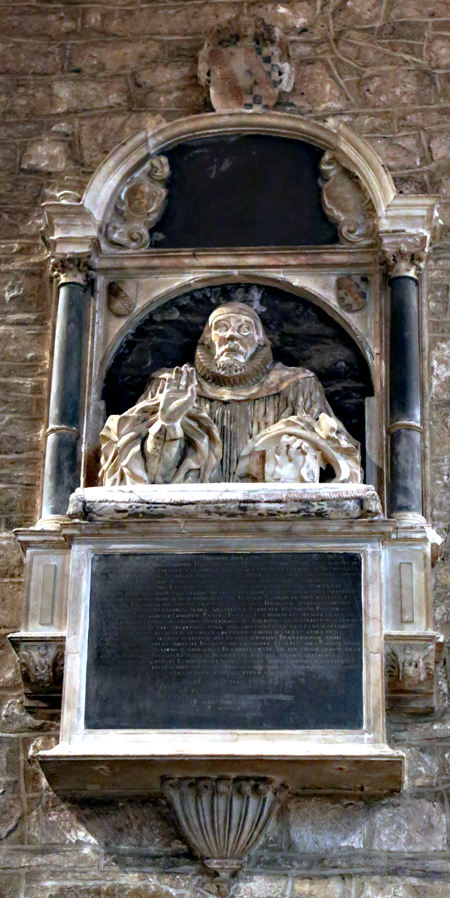 |
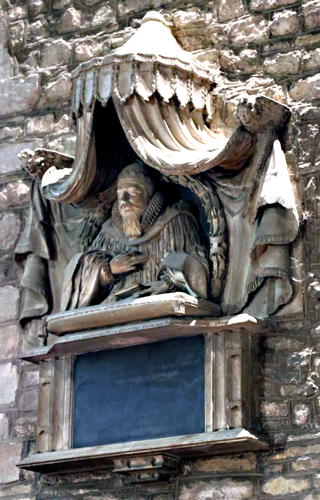 |
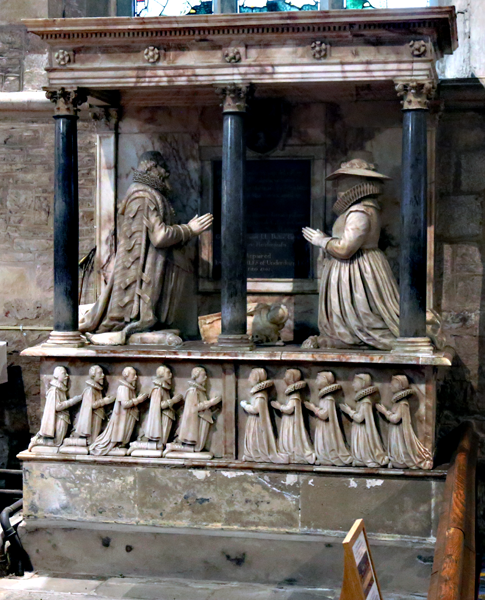 |
| Above left: [1]
Dr Thomas Thornton (1629)
Master of
St Katherine's Hospital. Wall monument with bust in ruff
and skull cap. Five shields of arms. Above centre: [2]
Dr [John] Hoskins [1631]
Wall monument with bust in ruff and cap. Draped
canopy with cherub's head. One shield of arms.
Right :[3] Edward Skinner (1631)
and his wife,
Elizabeth (1628-9).
Large
alabaster and marble free standing wall monument.
Base and canopy. On the base a kneeling male civilian
facing his wife in a big hat. Between
them is a recumbent figure of a female child, and on the
back wall an
inscription plate and a shield of arms. On the front of
the lower part of the base are kneeling figures of five
sons and five daughters. |
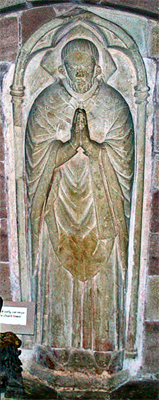
|
Other Monuments
Recorded by RCHM |
|
| Left: [5] Priest in mass
vestments. Mid - late 13th century. Now set upright
against a wall. |
| [6] Benjamin Pritchard,
prebendary of Hereford and vicar of Ledbury
(1701), and his wife, Gertrude (1727)
Plain slab. |
| [7] Edward Cooper,
archdeacon of Hereford and master of St Katherine's
Hospital, (1596) Slab with incised male
figure in ruff, cap and gown; the cap, sleeves and shoes
are painted black or blue and the lines formerly filled
with dark composition. |
| Right: [8] Elizabeth Hall (1708)
Draped white marble tablet with vase |
| |
| There are twenty floor slabs
recorded, dating from the seventeenth to early
eighteenth centuries |
| |
| There are eight brasses recorded
from the fifteenth to seventeen centuries. These
include: William Calwe (1410), a
kneeling figure of a priest; Thomas Capel (1490)
Knight with livery collar and (unusually) feet
on horse. |
|
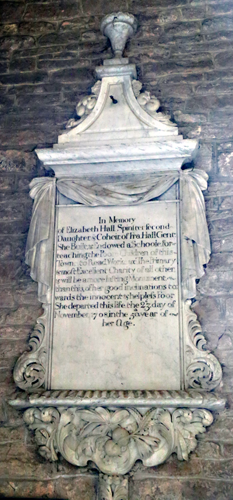 |
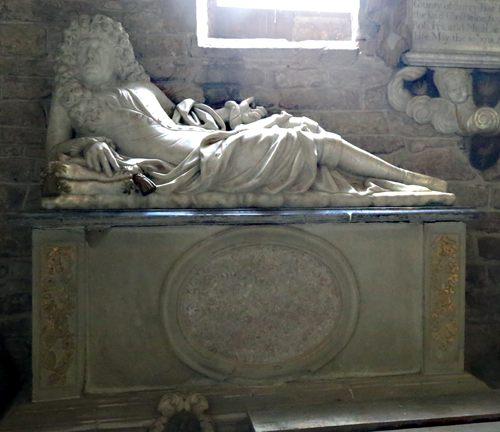 |
 |
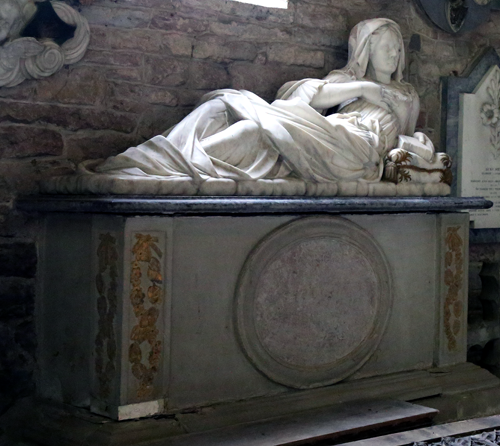 |
[9]
Constance Biddulph
(Hall) (1706) and her husband,
Anthony
Biddolph (1718) Marble monument with reclining
effigies of man and wife in costumes of the time.
Inscription tablet at the back with drapery, cherub's
heads and achievement and shields of arms.
This monument is in three separate sections which occupy the
whole width of the west of the south aisle and is surrounded by high contemporary
iron railings: it is therefore impossible to photograph the
whole monument in one shot. I had not asked for permission to
enter the enclosure formed by the railings which was not
otherwise readily accessible. I had to climb onto a table and
take the photographs over the top of the railings. The bright
light from the window caused problems which I was unable to
overcome: this was particularly bad with the inscription tablet,
as may be seen. |
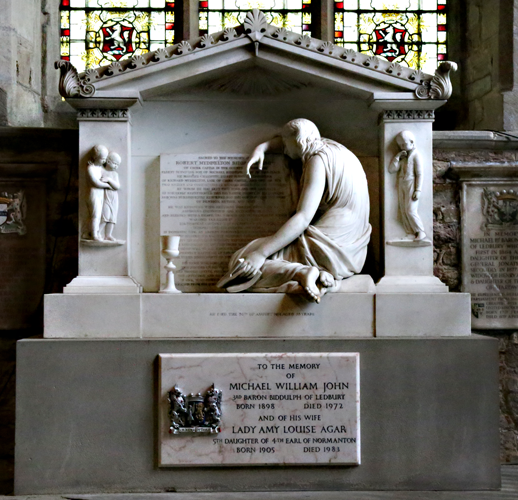 |
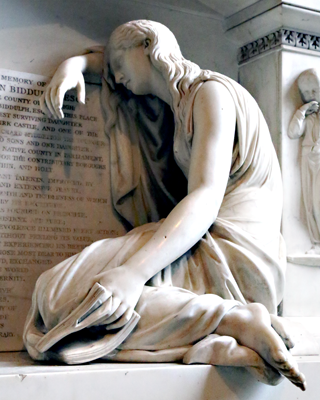
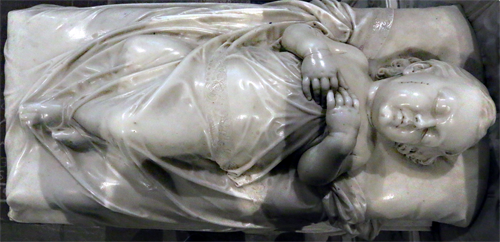 |
 |
Above and centre top (detail): On
the back inscription it reads to Robert Middleton
Biddulph (1814). On the tablet below the lady it reads,
Michael William John, 3rd Baron Biddulph of Ledbury
(1972) and his wife, Lady Amy Louise
Agar (1983). By: Sir Richard Westmacott.
Far right and centre bottom: John Hamilton (1851)
White marble effigy of a young child on a tomb chest
with two angels above and behind. By:
Thomas and his wife, Mary Thorneycroft. The monument
was displayed in the 1851 exhibition. |
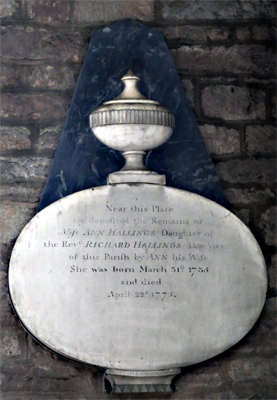 |
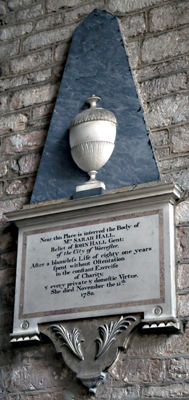 |
 |
 |
|
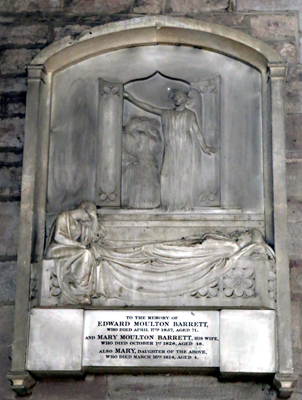 |
Above left: Miss Ann Hallings (1775).
Above centre: Sarah Hall (1780).
Above right: John Mills (1842).
Near right: William Skynner (1670) Mostly
faded to illegibility. Far Right: Edward Moulton Barrett (1857);
and his wife, Mary Moulton Barrett (1828); and
their daughter, Mary (1814) Aged 4 years. By
J. G. Lough. He lies on a couch, a woman mourns at his
feet, and behind an angel opens a door. |
***
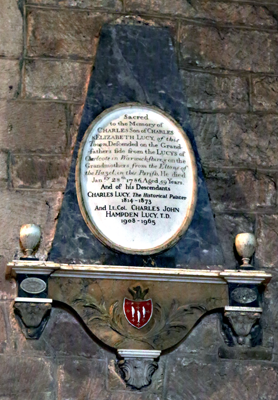 |
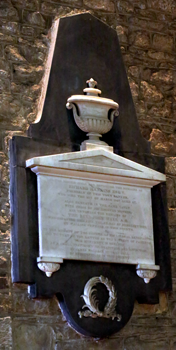 |
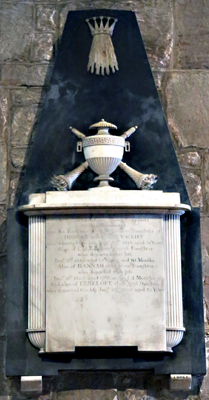 |
 |
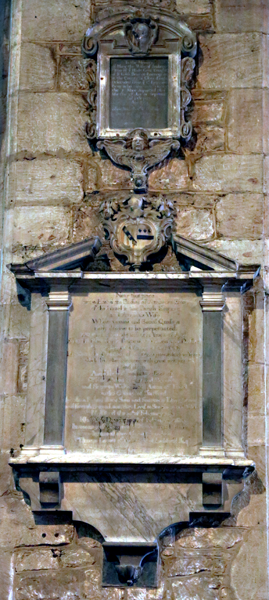 |
Above far left: Charles Lucy (1786).
Added
later, and his descendants:
Charles Lucy (1873),
the historical painter; and Lt Col Charles John Hampden
Lucy TD (1965). Centre left:
Richard Hankins (1807);
buried in the family vault together with
Rev John Hall
AB Centre right:
Anne Skip (1818)
21; and her sisters,
Ellen (1819)
11,
Hannah (1820) 17, and
Penelope (1823)
12. Far right:
William Bellers (1808).
Elizabeth Bellers (1800) Right: Not
legible.
Below far left: Daniel Ellis Saunders (1825)
By Flaxman. Centre left:
Grace... The rest is virtually illegible.
Centre right: William Miles (1802) and his
wife, Sarah (1823). And their daughters:
Sarah (1785), Elizabeth (1800),
and Milborough (1800). And their sons:
William (1790), Robert John (1797),
and John Robert (1780). All are buried in this
church with the exception of Milborough and John Robert who are
buried at Westbury, Bristol. The structure behind te figure
is an obelisk not a giant candle with which it might be confused
as a result of the unfortunate position of the lighting! .By Flaxman. Far right:
Cpt Samuel Skynner (1725) '... no
mean proficient in Maritime affairs....' By Thomas White.
Unfortunately the lower part of this monument is obscured by a
church notice board.
|
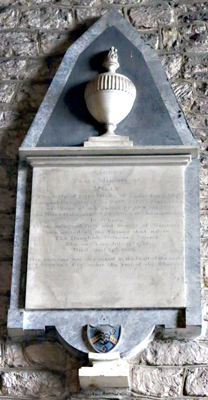 |
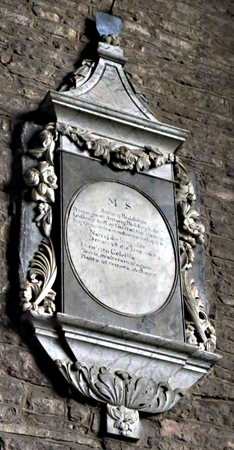 |
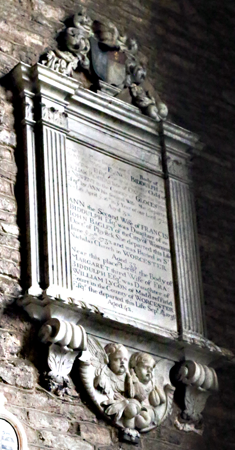 |
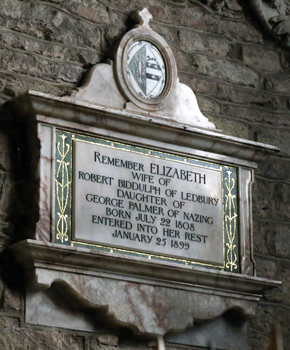 |
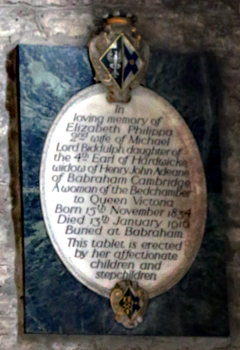 |
|
| Far left: Milly Miles (1805).
Mid left: Antony Biddulph (1689)
Latin text. Near left: Francis Biddulph (173_);
his second wife, (Ann Bagley) (1732); and his
third wife, Margaret (Lygon) (1736). Above
left: Elizabeth Biddulph (Palmer) (1899).
Above right: Elizabeth Philippa Biddulph (1916) |
|
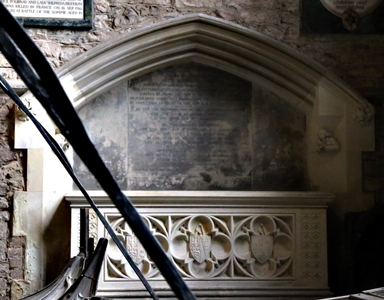 |
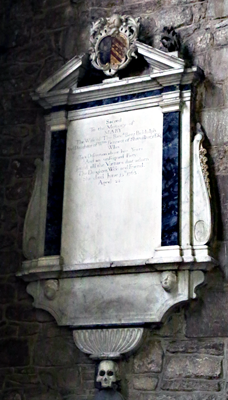 |
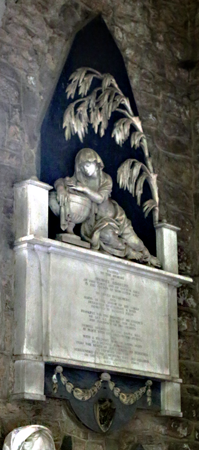 |
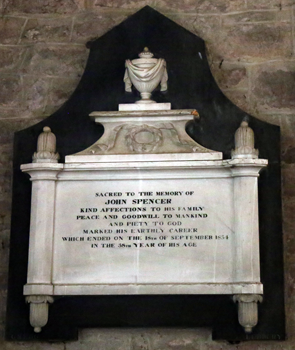 |
 |
| John Biddulph (__) |
Mary Biddulph (1763) |
Michael Biddulph |
John Spencer (1854) |
Elizabeth Spencer (1843)
and her husband, Timothy Spencer (1849) Signes:
Cooke Gloster |
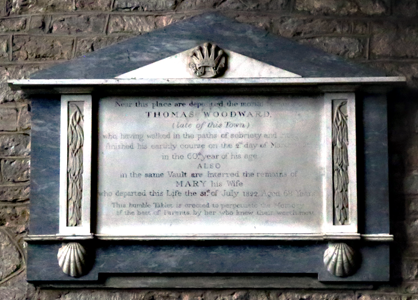 |
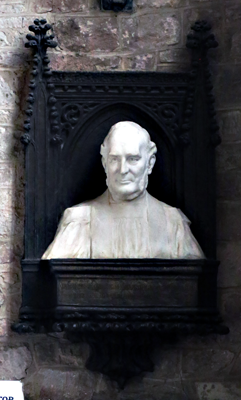 |
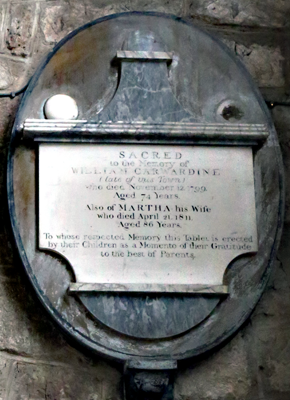 |
|
 |
| Thomas Woodward (182_) and
his wife, Mary (1822) |
Rev. Prebendary C. E. Maddison Green
R D. |
William Carwardine (1799)
and his wife, Martha (1811) |
|
Charles [Berron] (1738) and
his wife Jane (1787) |
| Other Monuments |
| |
|
| John Martin (1880) ; his
wife, Mary (Moss) (1843) and others. |
Large brass with raised lettering and
botanical border |
| Cpt Evan Hamilton Martin RN JP
(1945) |
Brass with five military medals |
| Mjr Hugh Waldyve Martin (1918)
59th Scinde Rifles; buried at Jullundur. Also his
brother, Cpt Alick Gregory Martin MC (1918)
Princess Patricia's Canadian LI; KIA Flavey-le-Martiel, France.
Unknown grave. |
Brass with two military medals |
| Lt George Dermot Martin (1908)
1st Batt. Royal Warwichshire Reg. DOW Matta Moghal
Khee, India. Brother of the above. Buried with Pte W. Adams and
others of his regiment at Matta Fort |
Brass with military medals, badge, images of
infantrymen, etc |
| Ernest Robert Preece (1951)
Churchwarden |
Brass |
| Katharine
Biddulph (1888) |
White oval tablet on black base |
| Michael, 1st
Baron Biddulph of Ledbury (1923) |
White marble tablet with raised edge and
cornice. Three coats of arms |
| John Michael
Gordon, 2nd Baron Biddulph of Ledbury (1949) and his
wife, Marjorie Caroline Susan (Mure) (1961) |
As above but white/light brown. One coat of
arms. |
| William Gordon
(1836) |
White tablet with cornice and low pediment,
arms at base. Gray backing |
| James Williams
(1858) and his wife, Abigail (1875) |
White with cornice containing cross, base,
and black backing |
| Dame Maria
Eliza Boyer Gresley (1840) |
White sarcopagus with feet standing on low
shelf. Black base.
S Lewis Sc Cheltenham |
| Victor Roundell
George Biddulph (1916) 2nd Lt Rifle Brigade. KIA Somme
at 19 |
White tabler with black frame, marble |
| Francis
Biddulph (1794) Physician at St Batholemew's Hospital |
White oval tablet, long axis vertical pm
rectangular black back |
| George Tournay
Biddulph (1929) |
White tablet with cornice on black back |
| Penelope
Biddulph (1818) |
White tablet with cornice and pediment, on
which IHS and cross; pillasters supported by shells. |
| Robert Bellere
(1832) |
White tablet in Gothick frame |
| George Woodyatt
MD (1832) |
White tablet with cornice and pediement, the
latter with large scallop shell. Snake coiled around staff in
base of tablet |
| Ann Fortune
(1820) |
White tablet on gray background |
| |
|
| Charlotte
Ballard (1824) |
White tablet with pediment and base on black
backing |
| Ella Doveton
(1921) Wife of Ren. Preb. C. E. Maddison Green
(Haggard) (1921) |
Oval tablet, long axis vertical with wreath
surround |
| |
|
|
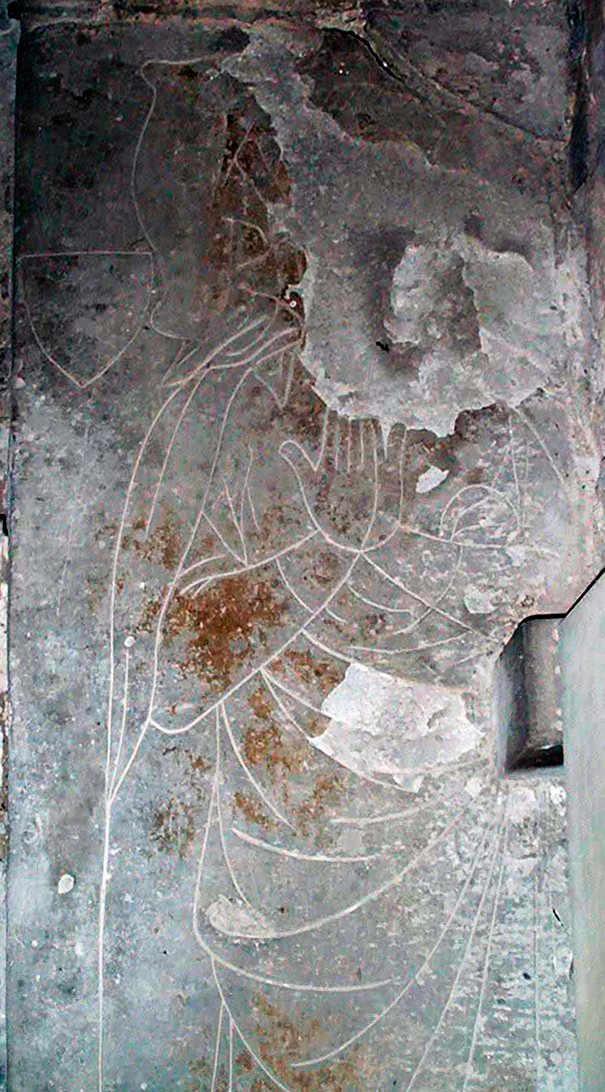 |
 |
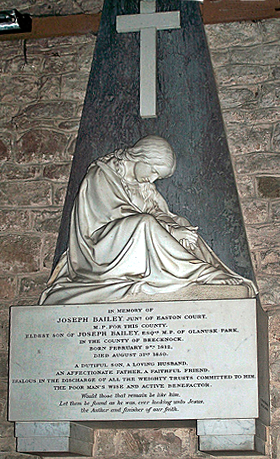 |
| Incised slab of lady in recess;
c. 1340 This incised slab is in one of two
recesses in the north wall of the chancel |
Joseph Bailey (1850)
by J Evan Thomas |
| There are also six floor slabs
recorded |
|
|
Lugwardine - St Peter |
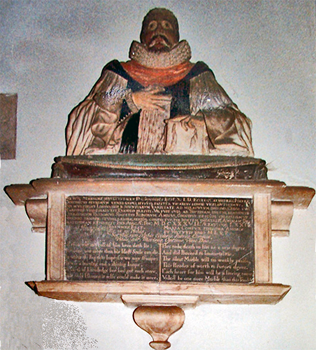 |
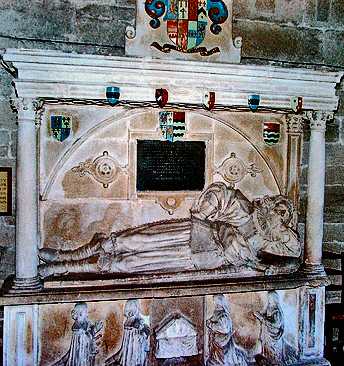 |
| [1]
John
Best STD, canon of
Hereford and vicar. Tablet of slate and alabaster. |
[3] William Reed, sheriff and JP,
(1634) Note the two sons and two
daughters kneeling at prayer desk. |
| Further
Monuments |
|
[2] Jane, successively wife of Robert
Kirle and John Best (1622)
Wooden tablet with brass plate with inscription
and figure of a woman kneeling in a church. |
|
|
Lyonshall - St Michael |
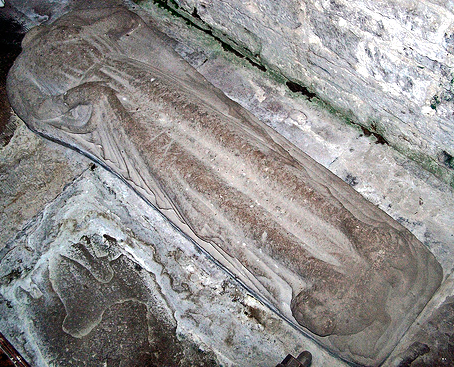 |
| [2] Male Civilian Probably 13th century. Headless.
Remains of sword |
| Further Monuments |
| [1] James Lloyd (1693)
Stone and marble tablet |
|
|
 |
Moccas - St
Michael and All Saints |
 |
The church is open during daylight hours.
Follow signs to Moccas and then to Moccas Hall Hotel (which may
be seen on the right); then turn left on a road signposted
church. There is plenty of parking outside. Note that the
door may be stiff to open and need a hard push.
|

Above:[1] Knight of c. 1330. Note the
layer of armour below the surcoat which is shortened at
the front. Cross legs Effigy somewhat restored; chest
probably original. |
 |
 |
 |
 |
 |
|
|
| Mary Jane Cornewall (1839)
Drowned in River Wye at 17 |
Catherine Cornewall (1835)
Difficult to read, the incised letters having lost their
colouring |
Sir George Corewall Bt (1835) |
|
|
| Other Monuments |
| Charles _ Cornewall
mostly illegible |
White tablet with pediment on gray backing |
| Sir George Corewall Bt (1819) |
White table. Black base and shelf and
pediment, in which arms |
| Jane Cornewall (Naper) (1852) |
Gothick |
| |
|
| |
|
| |
|
| |
|
| |
|
| |
|
|
|
Much Cowarne - St Mary |
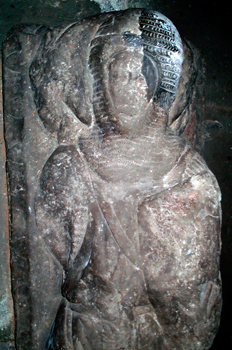 |
| |
| Above: [2] Late 13th
century knight. The shield shows remains of a lion. His
legs are crossed but broken off. |
| [1] Sybil Read (1624)
Recumbent effigy of a woman in costume on the period.
The paneled back piece has kneeling effigies of two sons
and two daughters with three shields of arms. |
| [3] Edmund Fox (1617)
and his wife, Ann. Altar tomb
with effigies of male civilian and lady. In front of the
tomb chest kneel three sons and seven daughters,
while at the east end are three infants in a cradle. On
the wall above is a tablet with shield of arms |
|
|
| |
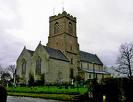 |
Much Marcle - St
Bartholomew |
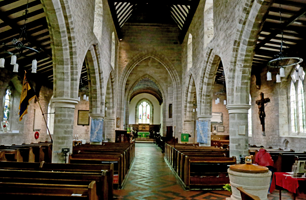 |
The church is open; it is situated on a
country road and you can park outside but space may be
difficult.
O/S Ref: SD 657 327 |
 |
 |
| [5]
Civilian (1360-70) Oak painted.
Unidentified but said to be Walter de Helyon (c. 1350) . Note the cross legs - unusual for a civilian
effigy. The effigy is said to have been originally in Ashperton
but moved here when the chancel of that church collapsed. |
[1]
Blanche Mortimer, Lady Grandison (1347)
The monument is of oölithic limestone and
has three tiers: the tomb chest, the central space with the
effigy, and the canopy. Note that the bottom of Blanche's gown
falls over the lowest tier, obscuring the niche below. There are a number of shields
which are suspended by straps from a series of heads: on the
tomb chest large beaked birds and lions alternate except the
front westernmost which is from a dog; on the lower part of the
canopy they are suspended from lions' heads,
except for the central one which is from the head of a bearded
man, and the most easterly which is from a dog. On the upper
part of the canopy (the cornice) the straps are looped over
flower heads. On the shields are the arms of Grandisson and
Mortimer; assuming the repainted heraldry is an exact copy of
the original painting the two shields most likely represent a
marriage; the only known marriage between the two families was
that of Blanche and Peter de Grandisson in 1320.
Blanche's head rests on a fat cushion and her feet on a dog; the latter
is now headless but the head was originally a separate piece held by
a dowel, as may be deduced from the hole which can still be
seen. Unusually for the time her hands are not in prayer but
rather the right lies across her waist while her left rests on
her abdomen, holding a rosary. There are two rings on her right
hand and one on her left. Blanche wears a elbow length fine veil
over which can be seen on the forehead the front of a circlet.
Under the veil is worn a wimple and over all is second
veil of thicker, heavier material. Her dress is extra long, falling over her feet;
her cloak is even longer and is held by
a cord passing from shoulder to shoulder.
Restoration of this monument began in 2011 and
was completed in 2012; much was discovered during this conservation
work.
A body wrapped in lead was found inside the tomb chest lying on
a rough bed of stones and covered by a stone shelf which also
supported the effigy; this is
unusual as burials associated with medieval monuments usually
occur below the ground even if a tomb chest is present.
Blanche's body had been wrapped in lead and the joints sealed by
soldering; lead is an expensive material and could be afforded
only by the wealthy. It seals the body, excludes air and so aids
preservation. The lead was not opened but there were a few holes
at the foot end and some small bones could be observed with an
endoscope.
Very much more information - with
many excellent photographs, including those taken during the
dimantling of the monument prior to its restoration - may be
found in The Tomb of Blanche Mortimer, Lady Grandisson
by Brian and Moira Gittos. I believe this is only
available from the church so contact the churchwarden at the
church if you want a copy a copy.
|
| Who Was Blanche Motimer? |
Blanche Mortimer was a daughter of
Roger
Mortimer, 5th Baron Wigmore and Earl of March, -1 a powerful
Marcher
Lord who gained many estates on the Welsh Marches
following marriage to a wealthy heiress, Joan de Geneville,
2nd Baroness Geneville. Blanche was one of eleven children
of this marriage, seven of whom were girls. She died in 1347 in
her early forties.
Blanche married Peter de Grandisson (d. 1358) in 1320. He
held substantial estates in Herefordshire in the Much Marcle
area. His father, William, originally came from Grandisson, near
Lausanne (now Switzerland) and entered service in England with
Edmund, Earl of Lancaster, known as 'Crouchback', brother of
King Edward I. His arms appear on the latter's tomb chest in
Westminster Abbey. He died in 1358 and was buried in Hereford
Cathedral.(shown
here). The couple had no surviving children.
-1 There are a number of Roger
Mortimer, but this is
the particularly infamous one: he led the Marcher Lords in a
rebellion against the King, Edward II, in what is known as the
Despenser
War. For this he was imprisoned in the Tower from where he
escaped and joined
Isabella, the King's wife, in France. Isabella - known as the 'She Wolf
of France' - was the daughter of the French
King
Philip IV ('The Fair').-2
They almost certainly
became lovers and successfully invaded an already divided England; London had
declared for the rebels and the King fled, only to be captured
in Wales.
The rebels declared King Edward II unfit to rule and Prince Edward -
son of Edward II and Queen Isabella - guardian of the
kingdom; Prince Edward was then a minor so the power passed to
Isabella - and her lover, Mortimer. The king was forced to hand the great seal
over to the rebels and this was delivered to Prince Edward and Queen Isabella
actually at Mortimer's residence in Much Marcle. In1327 the King
was formerly deposed and Prince Edward - now 14 - crowned as
Edward III. Edward II was
held and afterwards probably murdered in Berkeley Castle,
Gloucestershire, most likely on the orders of Mortimer.
For over three years this unlikely couple
effectively ruled the country before being overthrown in a
rebellion led by the teenaged Edward III. Mortimer
was hanged (but not drawn and quartered) as a traitor at Tyburn while
Isabella, who was initially put under house arrest, was allowed
to retire.
-2 In French he is known as Phillippe le Bel, 'Bel'
here being an old form of French of 'Beau', fine or, here,
handsome. The King was hardly 'fair' in the other - 'just' -
sense of the word! King Edward III was later to claim the French
crown by descent from his mother Queen Isabella. Phillippe's three sons each of whom
became king after him all died without issue. This failure of
the direct line of succession of the French crown was said to
have been the result of a curse upon the French King from the
last Master of the Temple, Jacques Molay, whom, with other
Knight Templars he burned at the stake.
|
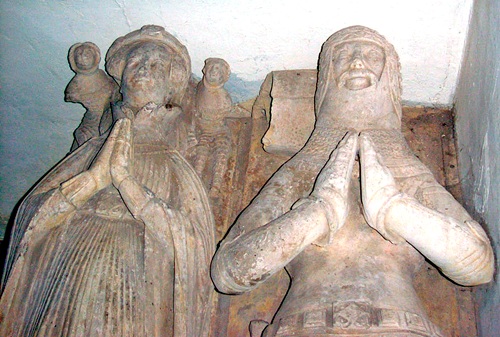 |
 |
 |
Above: [4] A tomb chest
with effigies of late 14th century; unidentified but likely to
be of Thomas Walwyn (1415) and his wife, Isabella (Hathaway).
His mother was Joanna (de Helyon) was the daughter of Walter de
Helyon: see the wooden effigy above. There is no inscription
nore heraldry to confirm this identification but Thomas's will,
written in English, exists and in it he asks to be buried in
Much Marcle church. The style of the clothing and armour renders
this identification likely. |
t
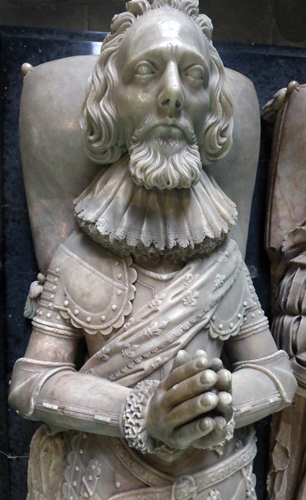 |
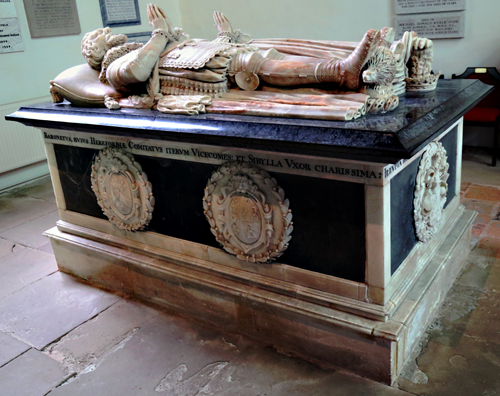 |
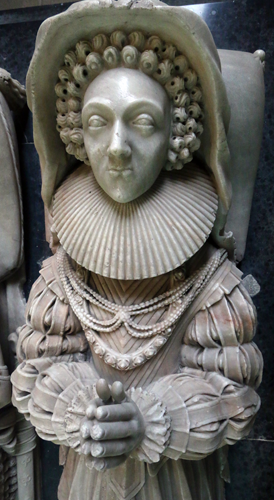 |
| [3] Sir John Kyrle Bt (1650) & Sibyl. Black
marble & alabaster |
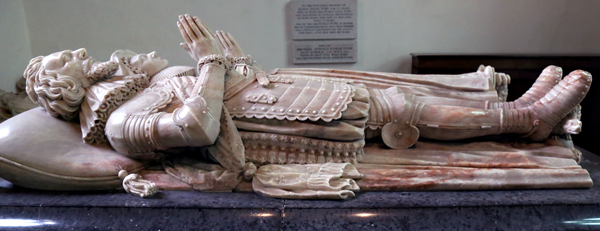 |
 |
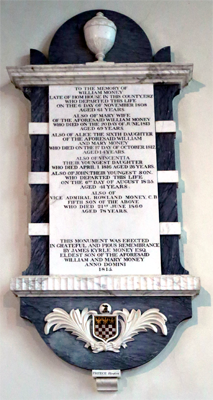 |
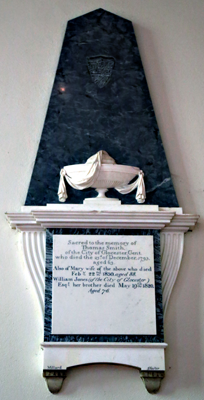 |
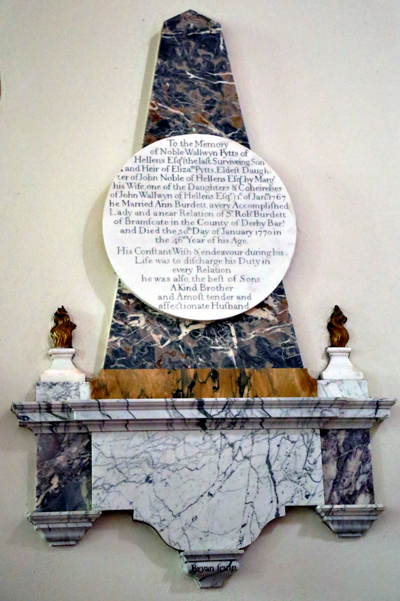 |
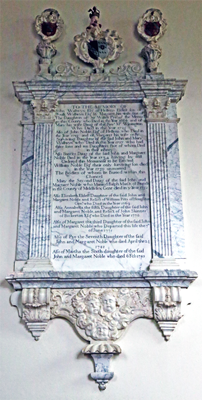 |
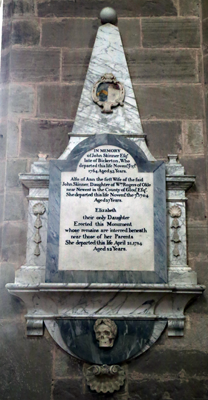 |
| Above from left to right: 1)
William Money (1808) and
his wife, Mary (1813). Their children:
Alice (1812) 6th daughter, 14; Vincentia (1816)
youngest daughter 26; John (1825)
youngest son 41; Vice-Admiral Roland CB (1860)
5th son. 78. 2) Thomas Smith (1792); his
wife, Mary (1830); her brother, William
Jones (1820). Signed: Millard. Glos'ter 3) Noble William Pytts (1770)
The two Christian names are the surnames of his grandfather and
his great-grandfather, both on the female line. Signed:
Bryan ſculp 4) John Wallwyn (1686); and
his wife, Mary (Winnington) (1725). Also,
John Noble (1719); and his wife,
Margaret (Wallwyn), who was the daughter of the above.
The latter had 3 sons and 10 daughters, 5 of whom died in
infancy: Frances (1734), who commissioned the
monument; William (1739). 'The Bodies of whom
lie Buried within this chancel). Also daughters: Mary
Marsh (1752); Elizabeth Pitts (1769);
Annabella Skinner (1770); Margaret
(1771); Pye (1781); Martha
(1785) 5) John Skinner (1764)
and his first wife, Ann (Rogers) (1704).
Also their daughter, Elizabeth (1784),
'whose remains are interred near those of her Parents'. |
Other Monuments
|
| George Money (1831); his
wife, Pulcheries (Bourbel) (1865); their son,
Sir Alonzo Money (1900) |
White tablet atop which draped urn; on black
backing |
| 2nd Lt Robert Cotton Money (1940)
The Cameronians (Scottish Rifles) KIA trying to rescue
a fellow officer |
Simple gray tablet with military badge |
| Daphnie Money (1968); wife
of Mjr Gen Robert Cotton Murray CB MC (1985)
Parents of Lt Money, above. |
Simple gray tablet with shield of arms |
| Kyrle Ernle Money MA (1846)
Vicar 3 years; Prebendary of Hereford Cathedral |
White tablet on black backing |
| Hariet Louisa (1837) wife
of Ernle Money Kryle (This is not a misprint of
the above). Their son Franci Lovel who died in
infancy. Also their sons John Francis (14)
and George Stoughton (11), who both
drowned in the River Lugg in 1868, the younger
attempting to save the younger. |
White tablet on black backing |
| Coroline Chatfield Money (1831)
(11) 4th daughter of Rev Kyrle Ernle Money and his wife
Mary Thomasa. |
Simple white tablet on black backing |
| Rev William Money Kyrle MA (1848)
42 years Rector of Yatesbury, Wilts; afterwards Vicar
or this parish; also his wife, Emma (1840) |
Large white tablet on large black base at
the top of which coat of arms |
| Agnes Jessie Pope (1968)
and her husband, Comm Rowlnd Kyrle Cecil Pope RN (1976) |
Simple gray tablet |
| Rear Admiral Michael Donald Kyrle
Pope CB MBE DL (2008) Son of the above |
Simple gray tablet |
| Mjr Gen Sir James Kyrke Money Bt
(1842) and his wife, Caroline Anne (1875) |
White tablet on black backing. Tablet has
wheat sheaf on top over which is draped a fabric which falls
down side of tablet. The lady's details are added on the base |
| Edward Kyrle (1841) Cpt
EIC. His sons: Richard Walter (1847) 6th Lt
32nd Reg of Foot; James Stoughton (1852), 4th.
Rector of Yaresbury, Wilts; George Washbourne FKC (1832) |
White tablet on balck backing |
| Mjr Audley Walter Washbourne
Money-Kyrle (1908) 55th and 19th Regs |
Simple white tablet with black frame |
| Florence Cecilia (1930)
wife of the above |
Simple white tablet with black frame |
| William Lowther Ernle Money-Kyrle
(1880) |
Simple white tablet |
| Ernle John Audley Money-Kyrle (1897) |
Simple white tablet |
| Alice Eleanor
Money-Kyrle (1890) Sister of William, above |
Simple white tablet |
| Eugena Emma Money-Kyrle (1923)
Sister of William, above |
Simple white tablet |
| Mary Maitland Money-Kyrle (1940) |
Simple gray tablet |
| Rowland Tracy Ashe Money-Kyrle
(1928) Archdeacon of Hereford and Canon of the
Cathedral. Brother of William, above |
Simple gray tablet with leaf border |
| William Money Kyrle (1868) |
White tablet on black pedimental black
marble base. Draped arms of badge of wheat sheaf on top of
the tablet |
| Lt Col John Ernle Money-Kyrle (1894)
32nd regiment. His wife' Ada Frances (1918) |
White tablet on black marble base, both
pedimented. Tablet has floral border. |
| Catherine Moore Ponsonby Caulfeild
(1834) |
White tablet with draped urn above and arms
below, on black marble backing with curved pediment. |
| John Elton (1765) and his
son, Peter (1781) |
Simple round tablet |
| Rev Prebendary Graham Frank Holley
(2008) Vicar 1967-1994 |
Simple stone tablet |
| John Murray Duncan (1936)
Vicar 1922-1927, then precentor of St Paul's Cathedral, Uganda |
Simple stone tablet |
| Allan William Chatfield MA (1896)
Vicar 48 years |
Brass with patterened border on black
backing |
| Edward Wallwyn (1831)
Barrister of Inner Temple |
Low pedimented white tablet on black base |
| Charles Radcliffe Wallwyn Cooke MP
(1911) |
Brass on black backing |
| Mary Duncan Cooke (1923)
2nd daughter of above |
White tablet with marble frame |
| Mary Cooke (1861) 21; her
mother, Mary Anne Cooke (1871); and her father,
Robert Duffield (1882) |
White tablet with plain paediment and base
on black marble backing. Signed: J Hards Henry St Ross |
| Commander Radcliffe Cooke RN
([1]98_) |
Brass with embossed lettering on black
backing |
| John Barnes; his wife,
Isabella; their son, John. No
dates or details. Added below; but these incised letters have
not been painted, unlike the former: ' Alſo
Mary, their Daughter. Alſo
Ann Hooper, their Dau.r' |
Very plain vertical white tablet. The lower
half is blank |
| Easter Godsall (1812); her
husband, Thomas Godsall (1819) |
Black and white tablet with pediment and
apron. Signed: G_[oc]h (Gooch?) |
| Dudley Persse White (Col
Austrailian Army) and his wife, Lynette Carle |
Incised wooded tablet on gray stone backing |
| Tomas Wigmore Wilding (1954)
Headmaster of Much Marcle School 1922-46 |
Simple stone table |
| The west window was restored by the above in
memory of his wife, Florence Amy Wilding (1949);
to her mother, Mary Martha Deakin (1932); and
to the above's parents, Thomas (1931) and
Jane (1931) Wilding |
Tablet similar to above |
| Thomas Charles (1912)
Church warden 1870-1906; his wife, Sarah (1891);
their, son James Alfred Henry Charles (1914)
church warden 1906-1912 |
|
| |
|
|
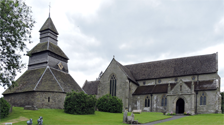 |
Pembridge - St
Mary |
 |
| The church is open. Parking is difficult:
there is a car park a short distance from the church, otherwise
there is scattered street parking. Nevertheless, this is an
interesting and friendly church and well worth a visit. |
 |
[1] The above is described by the RCHM as
an altar tomb with two pairs of effigies and dated mid-14th
century, giving the monument a single reference number. I was
unable to remove the chairs but the effigies certainly do not
seem to fit, there being a later extension of the chest at the east end. They
are against the north wall of the chancel. Local volenteers have
made full size copies of the clothing and these are on display,
on manikins, in a class case in the church. Details are shown
below. |
 |
 |
 |
 |
Civilian/Lady
Western pair. The man wears a turban head dress, belted
cotehardi reaching the knees and a loose cloak. He carries a
dagger and his feet rest on a lion. The lady wears a square
headress, hanging sleeves, and a button cloak. Her feet rest on
a dog. |
Civilian/Lady
Eastern pair. The man wears the robes of a serjeant-at-law: coif
with chin strap, long robe and short cape. His
feet rest on a lion. The lady wears a gown with tight sleeves, cloak
tucked under her left arm, wimple and veil. Her feet rest on a dog. |
 |
|
 |
 |
 |
 |
| [2]
Anne Sherborne (Cocks) (1668/9) |
|
[3]
Thomas Trafford STP (1685) |
[5] Alice
Sherborne (Davenant) (1660)
Wife of William, rector.
|
[6] William
Sherborne (1671)
Probably but now illegible |
[7]
Thomas Hopwood (1679) |
| Note: Photographs of three of the
above were originally taken by Michael Statham and sent to me to
include on this page. They were excellent photographs but I
wished to include others which were similar. I therefore retook
these plus three others. Mr Stathsm's photographs are now on
file. |
 |
 |
 |

 |
 |
| Above left:
[8] Walter
Carwardine (1706) Tablet with scrolls and half round
head. Centre: Edward Croxall Whitehead
(1922) Cpt
Indian Army. Right: Rev Henry Evans MA
(1793) Rector; his wife, Elizabeth (1799).
Rev Henry's sisters: Joyce Evans (1776); and
Anna Margaretta Williams (Evans) (1790); and
Elizabeth Evans (1798); and his brother,
Evan Evans (1794); and his son, John
Evans (1824). Also Martha Williams (1768),
daughter of Anna Margarette Williams. Also Mary Ann
Evans (Steward) (1844) , wife of Henry Evans. Also
Charlotte Elizabeth Steward (1844) sister of Mary Ann
Evans. Also Rev Henry Evans MA (1848).
Near right top: John Williams (1791)
Near right bottom: [4] Jane
Breton (Sherborne) (1656)
Wife of Robert, Minister of
Pembridge. Tablet in moulded alabaster frame. Far
right top: Sybill Anne James
(1787) and her husband, John James (1799).
Far right bottom: John Guard STP (1829)
Latin text |
|
Other Monuments |
| |
|
Elizabeth Huish (Hornsby) (1792) and her
husband, rector, John Huish BD (1802) |
White marble tablet with narrow cornice |
|
John Bowle Evans JP DL (1906), and his son,
Frederick Bowle Evans (1896) |
White tablet, black back |
| Dr
Neil Balfour Reid MB ChB (2004) General Medical
Practitioner 3 years |
White
tablet |
| Frederick Reginald
Sturridge MC (1963) Physician and surgeon. London and
Pembridge |
Stone tablet |
|
Susanna Davies (1775) and her parents: Samuel
(1780) and Elizabeth (1800). Also
Sarah (1830), daughter of Samuel and Elizabeth |
Large whie tablet with apron,
cornice and pediment |
| |
|
| There are
nine floor slabs, three brasses, and a coffin lid used as
masonry reported. |
|
|
|
|
 |
Stretford - Sts
Cosmas and Damian |
 |
Stretford is a village
on a (yellow) Roman Road running
north-south and being south-east of Leominster; it is marked on the
O/S map and that is where your SatNav will take you. The village
is clearly signposted on the road when you reach it; however, there is no church
there. The actual church is about one mile away and there
is no direct road to it. You need to take the
A4410 (also a Roman
Road) which also runs north-south but is
south-west of Leominster. There is a signpost to the church east
from this road between the B44577
(which
joins the A4410 from the west)
and where the A4410 crosses the
A44 at a staggered cross
roads. Follow this signposted yellow road to the church which is
surrounded by farm buildings. The church is marked 'Stretford' on the map but
this could easily refer to a farm or other building in the area.
The church is open and you can park outside - limited space.
O/S Ref: SO 443 558 |
| The church is now under the care the
Churches Conservation trust. |
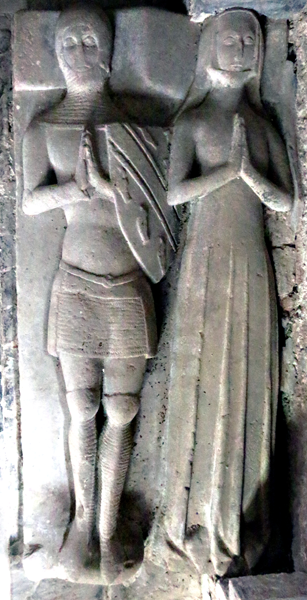 |
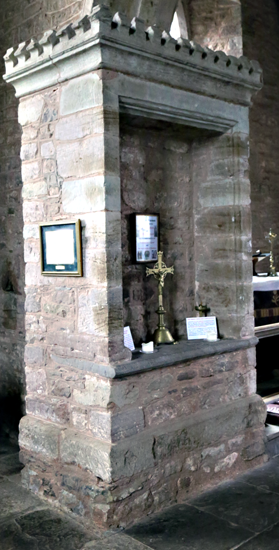
The Shrine of Saints Cosmas and Damien.
|
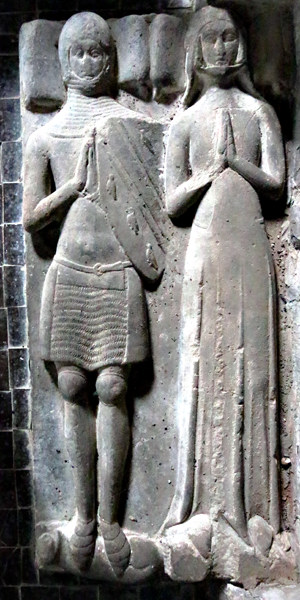 |
| [1] Knight and Lady in recess with a
moulded ogee arch. The knight wears mixed mail and plate
armour and a surcoat shortened at the front. He carries
a shield with athe arms of Delabere. His feet reat on a
beast. The lady wears a wimple and a long gown with
tight sleeves. C. 1320-30
and possibly
Robert Delabere
and his wife,
Margaret (Gamage) |
[2] Knight and Lady similar to
far left, but she wears a sideless gown and her feet rest
on a beast. In plain pointed arch.
C. 1340-50
and possibly
Sir John Delabere
and his wife,
Agnes (Turberville) |
Black Candles ?
or
Who Were Saints Cosmas and Damian ? |
Don't panic when you see those black candles: it is not what you
might think!
 Little is actually known about Saints Cosmas and Damian, except that they
were suffered martyrdom under the persecution of the Roman
Emperor Diocletian (245-313) in Syria. According to tradition they were
twin brothers from Arabia who became skillful physicians and
surgeons, practising in Syria then under Roman rule. They refused to take
any payments for their healing skills. They became Christians
and, with their three younger brothers, were tortured, refused to
renounce their faith, and so were then executed (c. 283). It is
said they were subjected to various method of execution - burning,
drowning, stoning and crucifying - all to no effect; they
were then beheaded. Little is actually known about Saints Cosmas and Damian, except that they
were suffered martyrdom under the persecution of the Roman
Emperor Diocletian (245-313) in Syria. According to tradition they were
twin brothers from Arabia who became skillful physicians and
surgeons, practising in Syria then under Roman rule. They refused to take
any payments for their healing skills. They became Christians
and, with their three younger brothers, were tortured, refused to
renounce their faith, and so were then executed (c. 283). It is
said they were subjected to various method of execution - burning,
drowning, stoning and crucifying - all to no effect; they
were then beheaded.
Their veneration rapidly spread beyond Constantinople and churches were
dedicated to them as early as the fourth century in Jerusalem,
Egypt, and Mesopotamia. Their relics were said to have been buried in
Cyrrus (Syria) from where they brought to Constantinople by the
Byzantine (Eastern Roman) Emperor Justinian who buried them in a
dedicated church there. Their feast day is September 26th.
They are the patron saint of physicians, surgeons, pharmacists, and
twins. There are very few churches
-1 dedicated to them in the United Kingdom: other
than here at Stretford these are in Southern England, and
include a Greek Orthodox Church at Gospel Oak (North London).
They also have images elsewhere: they are represented as statues
on the front of Salisbury Cathedral where one, said to be
Damian, holds a pestle and mortar, symbols of a pharmacist.
Damian is represented as the dexter supporter of the arms of the
British Dental Association.
The Black Candles. This tale dates only from a collections
of hagiographies of 13th century and appears only in Western
Christianity. It is written that a verger (sometimes a deacon
called Justin) had a diseased leg (either with a malignant
tumour or gangrene) which could not be treated. Saints Cosmas
and Damian appeared to the man in a dream and amputated the
diseased leg; they then removed a leg from a recently deceased
Ethiopian who had been buried nearby and transplanted this leg
onto their patient. When the man awoke he found that he was
cured and could now walk as well as before his illness. However
one leg was white and the new one black!
This miracle is represented in Stretford Church (I do not know about the
others) by using white and black candles in the candelabra on
their feast day. This is a very curious tale but I have been
unable to discover the significance of the different coloured
legs.
-1 These (other than Stretford) are: Blean,
Challock (both Kent); Keymer (Sussex); Sherrington (Wiltshire)
as well as the aforementioned church at Gospel Oak
|
|
Tarringon
St Philip and St James |
| |
| [1] Lady, early to mid fourteenth
century. She wears a sideless gown and cloak. In ogee
arched recess. Head on pillow supported by broken angels |
| |
|
Weobley
St Peter St Paul |
| Note: A notice on the door states
that this church is normally opened; however when we
arrived it was locked because of major work to the
floor. I did write for permissions but received no
reply. There is a little parking outside the church but
there is a large free car park a very short walk away.
Toilets in village |
| [1] Col John Birch MP (1691)
Standing figure of man in armour holding a
baton. He stands in a round headed niche on a pedestal.
Trophies of arms. White and gray marble |
| [2] Usually ascribed to Sir
William Devereux (1402) but bearing the crest
of Marbury. Stone altar tomb with alabaster effigy of
man in armour of c. 1430. He wears a hip belt and an SS
collar. His feet rest on a lion and his head on a helm
with a Moor's head crest. The tomb chest has panels with
blank shields. Defaced, arms missing. |
| [3] Sir John Marbury (1437)
and his unnamed wife. Knight and lady on altar tomb. The
latter is made up of old and modern pieces and rests in
a recess with a two pointed arch. He wears plate armour
with the details similar to those above. The lady wears
a sideless gown, cloak, collar and horned headdress. Her
head rests on an age supported cushion. Both effigies
are of alabaster and have lost their arms |
| [4] Altar tomb with modern sides and
ends. The slab is of marble with four round sinkings at
the angles. Early sixteenth century. |
| |
| There are reported six floor slabs
dating from the fourteenth to early eighteenth
centuries. |
|
| Col John Birch
fought for Parliament in the First Civil War. He proved
to be a courageous and energetic officer, taking part in
a number of battles and sieges. He was wounded at least
twice, on one occasion being shot in the stomach. He did
not fight in the second Civil War and was excluded from
parliament by Pride's Purge, which sought to remove all
those who wished to continue negotiations with King
Charles, even though he had proved to be duplicitous and
stubborn. Although a Presbyterian by upbringing he voted
for the Tests Acts which required holders of public
office to be members of the Church of England. He backed
the Glorious Revolution in 165 against the Catholic
James II. |
|
|
| The text on the monument at Ullingswick
(left) reads: |
'Here lyeth the body of
John
Hill gentleman heire to John Hill gent of the
Nether courts who marryed the eldest daughter one of the
co-heires of Hugh Brooke esquyer of Lounge Ashton in ye
county of Somerset: lyneally descendinge from the house
of ye Lord Cobham & had by her three sonns & two
daughters: these armes came by hir and he departed the
lyffe the thirde day of February in the XXXXIII yere of
the raigne of oure soveraigne lady Queen Elizabeth Anno
Domi 1590
upon whom the Lorde hathe
mercy' Painted stone panel.
John Hill (1590-1) is the recumbent figure. The kneeling figures
are: his wife, Elizabeth (Brooke), their
daughter, Jane and their sons, John
and Francis. Above, apart from
the shield of arms are two shrouded infants although I cannot
make them out on the photograph. |
|
| Other
Monuments |
| A 14th century slab with calvary, chalice
and book has had the initials IP 1699 cut upon it. Thought to be
John Pitt. |
| |
|
|
|
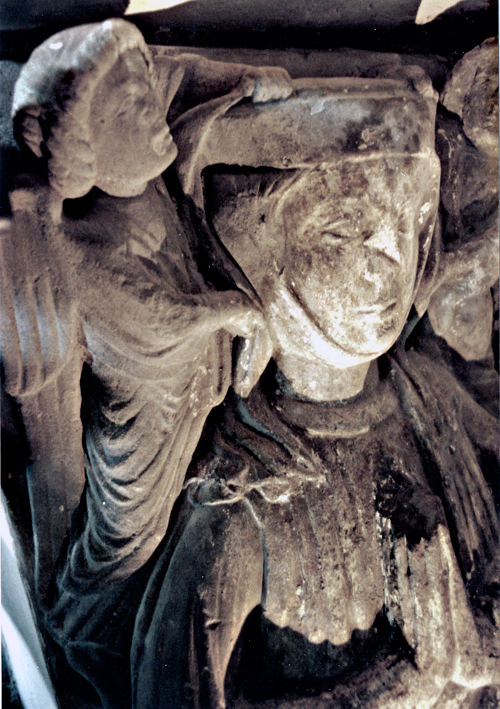
[1]
Mid 13th century effigy of a
lady.
Interesting feature:
The angels appear to be drawing a face
cloth away from the lady's face, best seen in the photograph to
the right. This is a very unusual feature and, to my knowledge,
only occurs on a handful of military effigies in Yorkshire.
Possibly, Joan de Genevile
| Other Monuments |
| [2] Ursula Awbury (1665),
Michael Hall (1640), William
Hall (1640-1), Mathew Hall Jnr (1688),
Mathew Hall Snr (1698),
Elizabeth Hall (1701) and others. Tablet with
arms and cherubs' heads. |
| [3] Jacob Hall (1709)
Small tablet with cherubs' heads. Probably the
husband of Elizabeth , above |
| |
|
m m m m mmmmmmm mmmmm,,,,,,,,,,,, m m m |
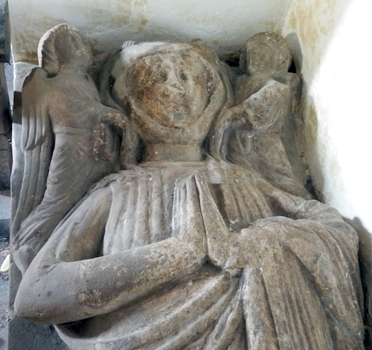 |
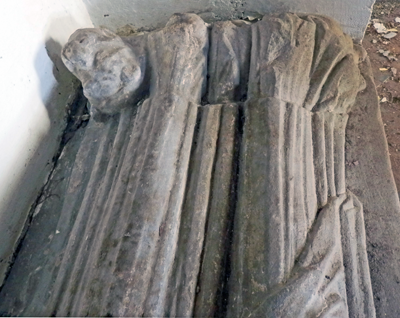 |
|
| |
| |
| |
| <Top of Page> <Herefordshire - 1> <Herefordshire
- 2>
<Herefordshire - Hereford Cathedral> <Gazetteer - Index - Home
Page> |
| |
| |




























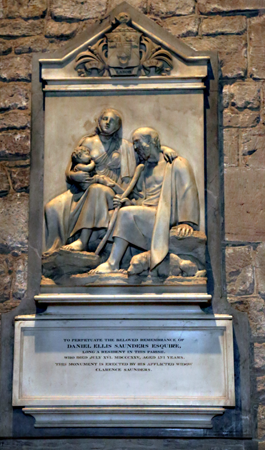
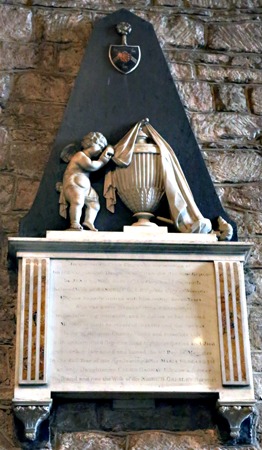
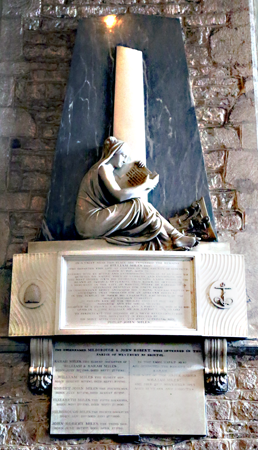






























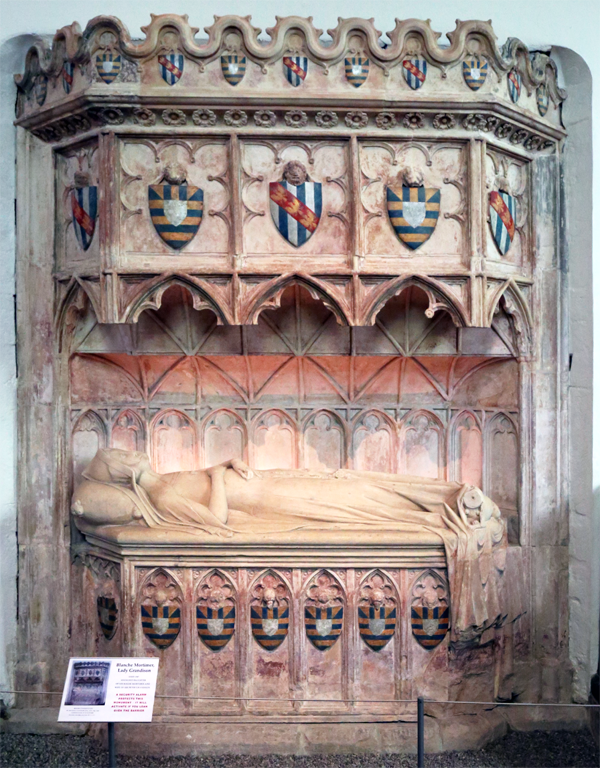
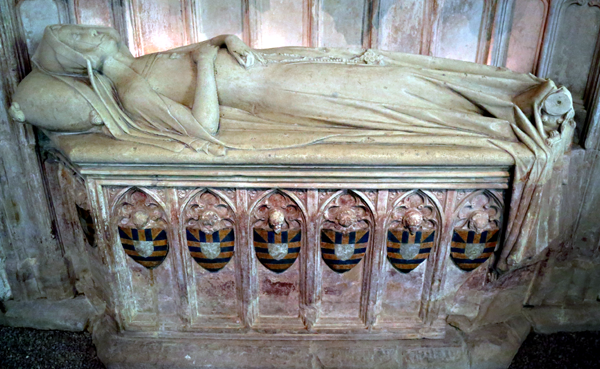




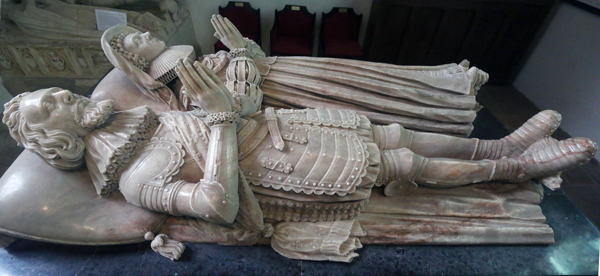
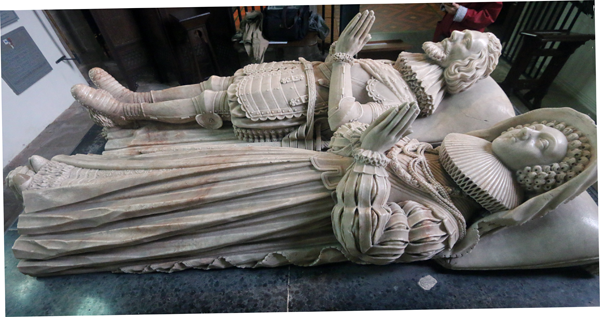

































 Little is actually known about Saints Cosmas and Damian, except that they
were suffered martyrdom under the persecution of the Roman
Emperor Diocletian (245-313) in Syria. According to tradition they were
twin brothers from Arabia who became skillful physicians and
surgeons, practising in Syria then under Roman rule. They refused to take
any payments for their healing skills. They became Christians
and, with their three younger brothers, were tortured, refused to
renounce their faith, and so were then executed (c. 283). It is
said they were subjected to various method of execution - burning,
drowning, stoning and crucifying - all to no effect; they
were then beheaded.
Little is actually known about Saints Cosmas and Damian, except that they
were suffered martyrdom under the persecution of the Roman
Emperor Diocletian (245-313) in Syria. According to tradition they were
twin brothers from Arabia who became skillful physicians and
surgeons, practising in Syria then under Roman rule. They refused to take
any payments for their healing skills. They became Christians
and, with their three younger brothers, were tortured, refused to
renounce their faith, and so were then executed (c. 283). It is
said they were subjected to various method of execution - burning,
drowning, stoning and crucifying - all to no effect; they
were then beheaded.







